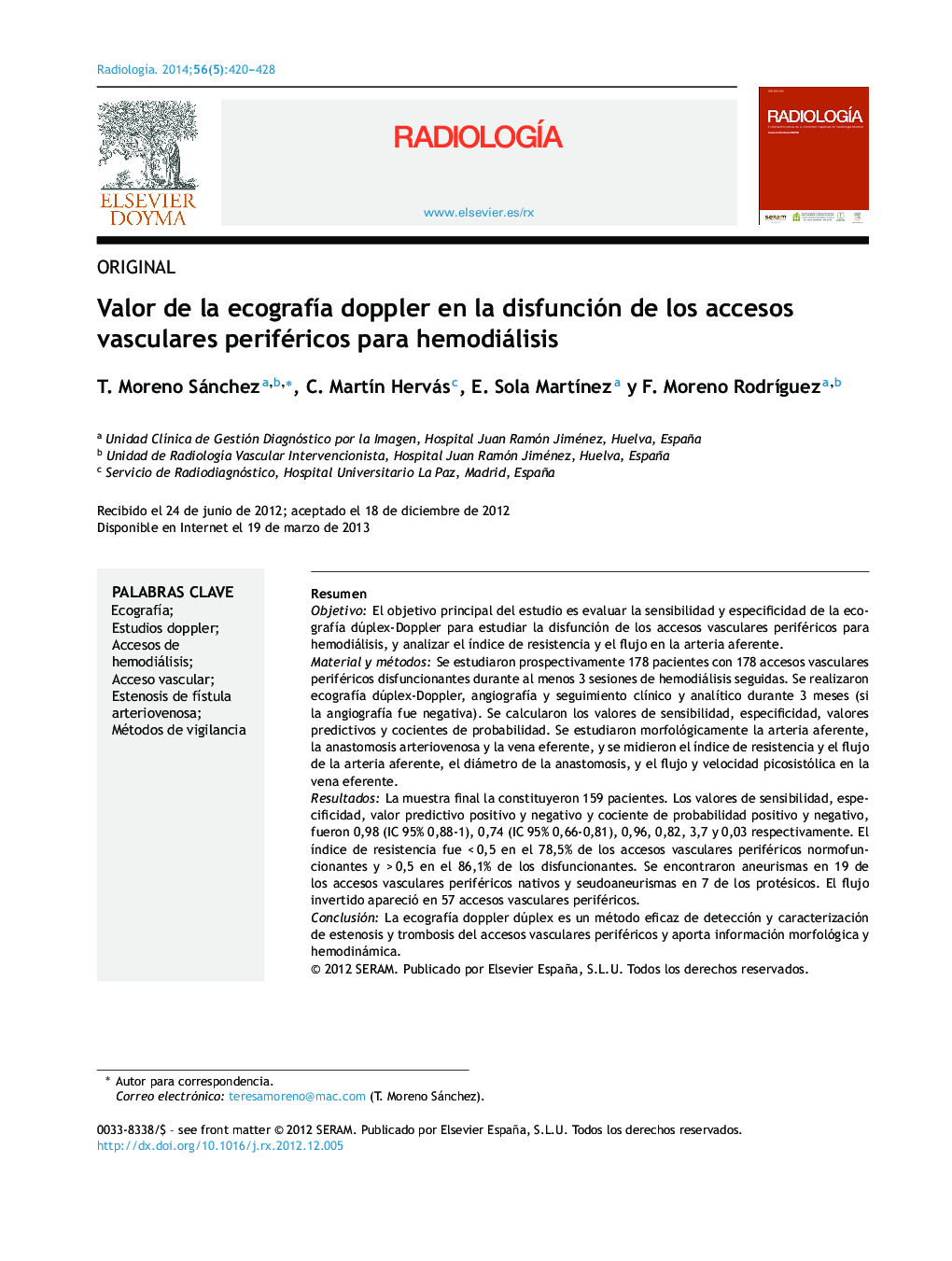| Article ID | Journal | Published Year | Pages | File Type |
|---|---|---|---|---|
| 4245236 | Radiología | 2014 | 9 Pages |
ResumenObjetivoEl objetivo principal del estudio es evaluar la sensibilidad y especificidad de la ecografía dúplex-Doppler para estudiar la disfunción de los accesos vasculares periféricos para hemodiálisis, y analizar el índice de resistencia y el flujo en la arteria aferente.Material y métodosSe estudiaron prospectivamente 178 pacientes con 178 accesos vasculares periféricos disfuncionantes durante al menos 3 sesiones de hemodiálisis seguidas. Se realizaron ecografía dúplex-Doppler, angiografía y seguimiento clínico y analítico durante 3 meses (si la angiografía fue negativa). Se calcularon los valores de sensibilidad, especificidad, valores predictivos y cocientes de probabilidad. Se estudiaron morfológicamente la arteria aferente, la anastomosis arteriovenosa y la vena eferente, y se midieron el índice de resistencia y el flujo de la arteria aferente, el diámetro de la anastomosis, y el flujo y velocidad picosistólica en la vena eferente.ResultadosLa muestra final la constituyeron 159 pacientes. Los valores de sensibilidad, especificidad, valor predictivo positivo y negativo y cociente de probabilidad positivo y negativo, fueron 0,98 (IC 95% 0,88-1), 0,74 (IC 95% 0,66-0,81), 0,96, 0,82, 3,7 y 0,03 respectivamente. El índice de resistencia fue < 0,5 en el 78,5% de los accesos vasculares periféricos normofuncionantes y > 0,5 en el 86,1% de los disfuncionantes. Se encontraron aneurismas en 19 de los accesos vasculares periféricos nativos y seudoaneurismas en 7 de los protésicos. El flujo invertido apareció en 57 accesos vasculares periféricos.ConclusiónLa ecografía doppler dúplex es un método eficaz de detección y caracterización de estenosis y trombosis del accesos vasculares periféricos y aporta información morfológica y hemodinámica.
ObjectiveThe main objectives of this study were to evaluate the sensitivity and specificity of duplex Doppler ultrasonography in the study of hemodialysis peripheral vascular access dysfunction and to analyze the resistance index and flow in the afferent artery.Material and methodsWe prospectively studied 178 patients with 178 peripheral vascular accesses that were dysfunctional in at least three consecutive hemodialysis sessions. Patients underwent duplex Doppler ultrasonography and clinical and laboratory follow-up for three months (provided angiography findings were negative). We calculated the sensitivity, specificity, predictive values, and coefficients of probability. We studied the morphology of the afferent artery, the arteriovenous anastomosis, and the efferent vein, and we measured the resistance index and the flow of the afferent artery, the diameter of the anastomosis, and the flow and peak systolic velocity in the efferent vein.ResultsThe final sample consisted of 159 patients. The sensitivity, specificity, positive and negative predictive values, and positive and negative coefficients of probability were 0,98 (95% CI: 0,88-1.00), 0,74 (95% CI: 0,66-0,81), 0,96, 0,82, 3.7, and 0,03, respectively. The resistance index was less than 0,5 in 78.5% of the peripheral vascular accesses with normal function and greater than 0,5 in 86.1% of the dysfunctional peripheral vascular accesses. We found aneurysms in 19 of the native peripheral vascular accesses and pseudoaneurysms in 7 of the prosthetic grafts. Inverted flow was seen in 57 peripheral vascular accesses.ConclusionDuplex Doppler ultrasonography is an efficacious method for detecting and characterizing stenosis and thrombosis in peripheral vascular accesses, and it provides information about the morphology and hemodynamics.
